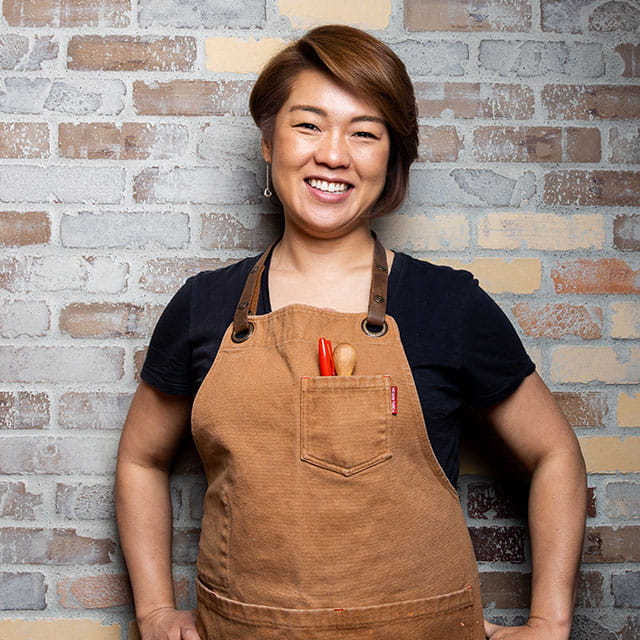
Chef Jinhee Lee
We stopped by Jin Bar to hear more of her incredible journey towards becoming Calgary’s Korean comfort go-to. View Culinary Connections for more.
Read BioA former Cordon Bleu Chef, winner of the Stephan Pyles Culinary Cook-Off Scholarship and a James Beard Foundation “Best Chef” Semi-Finalist, Chef Gabe Erales has been bringing the heat to Texas’ already rising culinary industry.
Now due to open his own restaurant, Dai Due Taqueria, this was the perfect time for us to talk with Chef Erales about his process for breaking down foods while building up savoury, hot flavours in his protein and vegetable-based dishes.
You’ve been recognized globally for your ability to maximize local resources such as proteins and vegetables from head-to-tail. Share with us your inspiration behind this style of cooking.
The majority of the inspiration has come from chefs I have worked for, such as Jessie Griffiths and Rene Redzepi. In my eyes, these two chefs have been pioneers of this technique in their respective parts of the world.
When using a product, whether protein or vegetable, I like to look at the total life cycle and how that can be reflected in the dish or cooking technique. For example, the use of avocados goes way beyond the flesh. Incorporating the flavours of the leaves as an aromatic in mole or beans is extremely powerful. Taking it a step further, both the leaves and branches can be used to create intense oil for seasoning and finishing.
Recently, I also used local peanuts to make a Peanut and Chile Arbol Salsa that was then smoked with the peanut shells.
In each case, inspiration was drawn from influential cooking situations where each of these chefs showed me a closed loop cycle of product life.
To maximize both the uses and flavours, describe your process or techniques for breaking down proteins and vegetables. Please provide examples.
My approach for this begins by breaking the product down into useable parts. This is followed by creating a systemic approach of cooking techniques for each to determine which maximizes the flavour and aesthetic of each product’s components. This approach is not limited to cooking and includes fermentation and preservation. A product may be extremely delicious prepared one way but not be overly presentable so you have to find a balance.
What are your go-to herbs, spices and seasonings for flavouring your creations?
Most of my creations are influenced by Mexican cooking. There will always be elements of heat (chilies), acid (citrus/vinegar/sour greens) and herbaceous (hoja Santa, epazote, bay, avocado leaf, papalo, cilantro, oregano) spices. There is also what is known as a recado spice base which includes allspice, cumin, cloves, peppercorn, coriander seed, and sometimes cinnamon. The recado spice mix comes from my family’s background in the Yucatán area of Mexico.
What role does your Mexican background play in flavouring the unique ingredients you prepare such as wild boar, venison and catfish?
The concept I am about to open now is a Taqueria that is based on the cooking philosophy developed by Jesse Griffiths and his flagship restaurant, Dai Due. Essentially, everything will be prepared in Mexican flavours, styles and techniques while utilizing wild game of central Texas in parallel to native produce from local farmers. This is beginning to reflect a lot of the same ingredients found throughout Mexico.
Wild boar and venison will take the places within items typically prepared with domestic pigs and lean cuts of beef. The destructive and ubiquitous feral hog, along with Hill Country venison, provide the foundation for our tacos, for example. These lean, rich, and wild meats are truly sustainable while also being readily available, allowing us to use them as a symbol of the regional food culture.
In addition to wild game, our menu will also reflect some of the finest pastured animals from local farms such as duck, turkeys and quail. Seafood from the Gulf and rivers of central Texas also find spots on our menu. Equally as important, our menu showcases the vibrant vegetables, fruits, herbs and cheeses grown around Austin.
What is the most unique ingredient you’ve used from head-to-tail? How did it impact the “raw” flavour profile?
Probably this last summer during the Noma Mexico pop up in Tulum. It was very exciting to be using the Noma/Nordic cooking techniques with the Mexican ingredients. Which, in my opinion, are the most interesting and delicious in the world. Noma is known for the use of ants in dishes for sources of acidity. We took that a step further in the lifecycle by using the ant eggs and escamoles on a dish. In parallel, using a different variety of ants, Chicatana, in salsas gives a very unique raw flavour of chili, garlic and citrus.